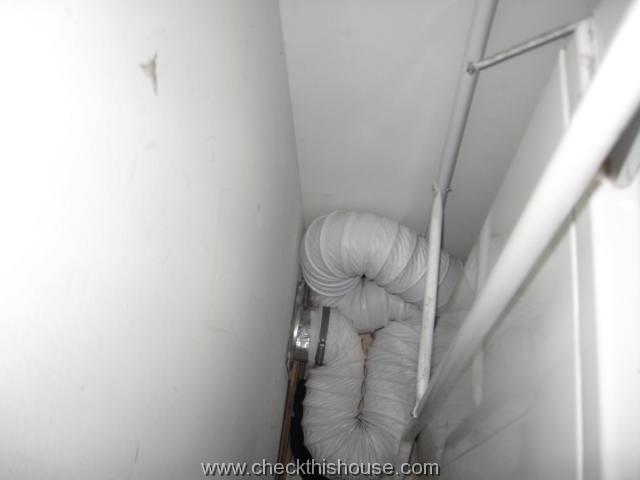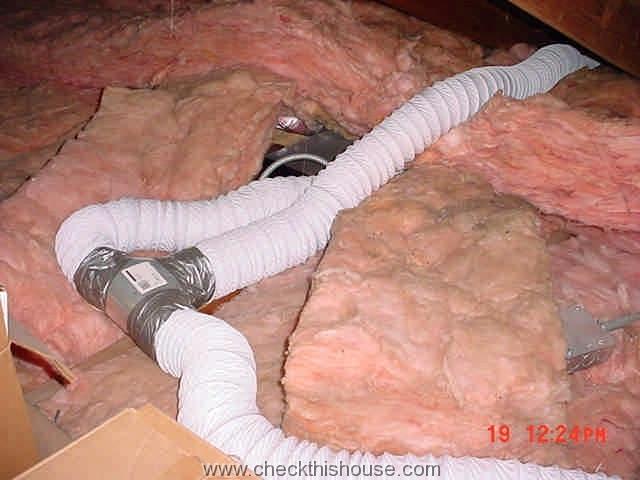- Is your clothes dryer vent discharging air from the appliance?
- Is your dryer vent clean?
- Does it take long to dry your clothes?
- Have you checked your clothes dryer vent pipe in the attic or crawlspace?
There are still many home owners that fail to comply with current building code requirements concerning their clothes dryer vents.
Unfortunately, the home owner could be the suffering one, not the code …
US Fire Administration report from January 2007 states:
- Clothes dryer fires account for about 15,600 structure fires, 15 deaths, and 400 injuries annually.
- Eighty percent of clothes dryer fires in structures occur in residential buildings.
- Annually, 12,700 clothes dryer fires occur in residential buildings resulting in 15 deaths and 300 injuries.
- “Failure to clean” is the leading factor contributing to clothes dryer fires in residential buildings.
- New home construction trends place clothes dryers and washing machines in more hazardous locations away from outside walls such as bedrooms, second-floor hallways, bathrooms, and kitchens.
The most common mistake that people still make is using plastic / flexible air hoses as a clothes dryer vent.
Plastic clothes dryer vent hoses were banned from being used for this purpose several years ago, but since we generally don’t like to read warning (or any) labels, some serious accidents happen.
An efficient operation of the clothes dryer depends on regular maintenance of its vent pipe, exterior hood / bird guard, and appliance lint screens (depending on your model, there is usually one or two lint screens installed).
Clothes dryer vent cleaning
Failing to clean all of the clothes dryer vent components on regular basis might cause the system to clog, significantly extend drying time, it may also overheat the plastic vent (that shouldn’t even be there) and, eventually, start a life threatening fire.
Depending on how often you use your clothes dryer, you should check the exterior hood / damper for lint accumulation and clean it as necessary. Protective screens are not permitted on clothes dryer vent termination.
- The material used for a clothes dryer vent should be rigid metal with a smooth interior wall (required for inside the wall installation, but ideally used for an entire vent section between the exterior and the dryer), or a corrugated semi-rigid pipe for the connection between the wall and an appliance.
The lint will stick even to the smooth wall of the clothes dryer vent, especially if you install long horizontal sections (get the maximum length from the dryer manual because its manufacturer might permit longer runs than the local building code).
- You’ll achieve the best efficiency of the appliance with the shortest possible dryer vent installed.
Don’t use any screws on clothes dryer vent pipe connections. Instead, you can seal them with aluminum duct tape (used to seal forced air heating ducts) and secure sections to the wall, framing or any other structure with straps – screws penetrating duct wall will trap more lint, which will eventually clog the pipe.
- Clothes dryer lint screen(s) should be cleaned before or after each load.
Metal foil (thin wall) flexible ducts used for the clothes dryer vent purposes are fire resistant. However, just like the plastic dryer vents, they’re extremely soft and easy to kink or brake behind the appliance. This could happen right after we install it and push our appliance back into its spot.

 Even if something heavier falls behind the appliance, it could crush that soft dryer vent wall and block / greatly reduce the airflow. Easy solution – don’t use plastic or metal foil dryer vents, get an offset dryer vent connector (also known as periscope, quick connector and probably some other names), which allows you to connect the appliance directly to the wall outlet, or at least eliminate bending of the flexible pipe behind the appliance.
Even if something heavier falls behind the appliance, it could crush that soft dryer vent wall and block / greatly reduce the airflow. Easy solution – don’t use plastic or metal foil dryer vents, get an offset dryer vent connector (also known as periscope, quick connector and probably some other names), which allows you to connect the appliance directly to the wall outlet, or at least eliminate bending of the flexible pipe behind the appliance.
Clothes dryer vent do’s and don’t’s
- Keep the area around the clothes dryer clean, and clutter free. For gas dryers – make sure that it has adequate air supply for combustion – don’t lock it in a closet behind the air tight door
- If the only possible gas dryer location is in your bedroom, make sure that dryer vent discharges to the exterior (some jurisdictions forbid bedroom installation at all, so check with your local building department). Even if your local building code doesn’t require it – install smoke detector and Carbon Monoxide detector in your bedroom.
- Never discharge clothes dryer vent into the attic, crawlspace, or garage, and check those areas periodically for loose, separated connections on ducts that run through it. If the area that the dryer vent runs through is unheated during the cold season, insulate it to prevent condensation from forming (you can get sleeve type insulation, which is very easy to install)
- Clothes dryer vent pipe penetrating house / garage wall must be at least 26 ga. steel, air tight / fire rated seal applied along the wall penetration and has to discharge to garage exterior
- Never connect a clothes dryer vent into the chimney (used or not by other appliances)
- Never connect a clothes dryer vent into the forced air duct system
- Never combine dryer and bathroom / kitchen vents together
- Have your clothes dryer cleaned periodically by a professional in order to remove all the lint that might accumulate inside the appliance enclosure
- Use special brushes designed for clothes dryer vent pipe cleaning













Comments are closed.